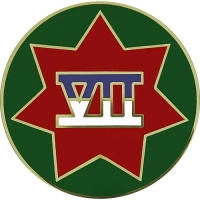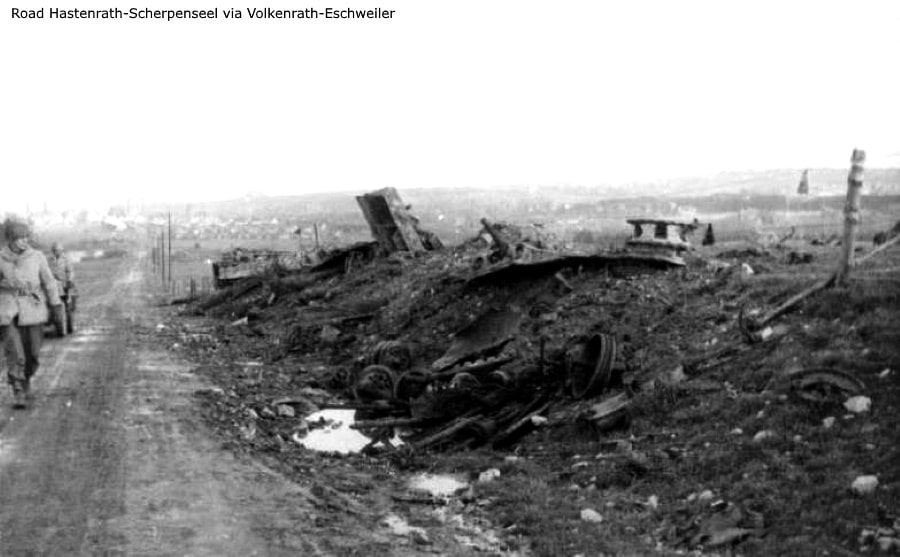The division received orders to commit its organic troops and Kampfgruppe Riedl in the front line to plug the gap between the 12.Infantry-Division and the 353.Infantry-Division (LXXIV Corps) while the troops attached from Kampfgruppe Jungklaus were to improve the bridgehead positions at Düren. The new boundaries of the 275.Infantry-Division were: in the north with the 12.Infantry-Division in Arnoldsweiler, Birkesdorf, Schlich, Schevenhuette, and Vicht; to the south with the LXXIV Corps, south of Düren to the south of Zweifall.
 On September 23, the 275.Infantry-Division established its command post in Düren and occupied its new sector. Late in the afternoon its troops had all but closed the gap, having secured contact with the 12.Infantry-Division, but were still marching to the Wenau Forest for contact with elements of 353.Infantry-Division. The day brought localized fighting in the Aachen and Stolberg sectors, as did the days to follow, but all actions remained inconclusive. The German front, as established on September 22, held against all attacks. The crescendo at Stolberg on September 22, in fact marked the end of the VII Corps recon in force in the LXXXI Corps sector. The Americans had deeply penetrated both bands of the West Wall, especially in the Stolberg Corridor, but on the whole, the Germans had scored a defensive success in denying the VII Corps a decisive breakthrough via Eschweiler to Jülich, Düren, and Cologne. The Germans had both emotional and materialistic incentives for offering such tenacious resistance in this particular area. They were defending the famous West Wall, their own soil, and such historic cities as Aachen. At the same time, the contested area was highly industrialized and contained many vital war production plants. For instance, a plant in the little town of Weisweiler (two miles east of Eschweiler) produced 40% of the national output of an alloy essential to the entire German steel production. From this point of view also the situation demands that the enemy penetration east of Aachen be wiped out, wrote Gen Brandenberger in a report to FM Model.
On September 23, the 275.Infantry-Division established its command post in Düren and occupied its new sector. Late in the afternoon its troops had all but closed the gap, having secured contact with the 12.Infantry-Division, but were still marching to the Wenau Forest for contact with elements of 353.Infantry-Division. The day brought localized fighting in the Aachen and Stolberg sectors, as did the days to follow, but all actions remained inconclusive. The German front, as established on September 22, held against all attacks. The crescendo at Stolberg on September 22, in fact marked the end of the VII Corps recon in force in the LXXXI Corps sector. The Americans had deeply penetrated both bands of the West Wall, especially in the Stolberg Corridor, but on the whole, the Germans had scored a defensive success in denying the VII Corps a decisive breakthrough via Eschweiler to Jülich, Düren, and Cologne. The Germans had both emotional and materialistic incentives for offering such tenacious resistance in this particular area. They were defending the famous West Wall, their own soil, and such historic cities as Aachen. At the same time, the contested area was highly industrialized and contained many vital war production plants. For instance, a plant in the little town of Weisweiler (two miles east of Eschweiler) produced 40% of the national output of an alloy essential to the entire German steel production. From this point of view also the situation demands that the enemy penetration east of Aachen be wiped out, wrote Gen Brandenberger in a report to FM Model.
 Gen Brandenberger to Army Gp B
Gen Brandenberger to Army Gp B
at 1100 on September 29 1944.
Army Gp B KTB, Anlagen, Lagebeurteilungen, Wochenmeldungen.
Much of the credit for the German defensive success undoubtedly belongs to the German communications and logistics. Had the exhausted elements of the LXXXI Corps which fell back to the West Wall about mid-September been left to shift for themselves, there can be no doubt that American forces would have broken through to Cologne in a very short time. But in spite of the extremely heavy losses the Germans suffered, their situation on September 23 was actually much better than it had been one week earlier. In the space of that week, the Germans had accomplished the extraordinary feat of moving three full-strength divisions to the Aachen area. Of these divisions, the 12.Infantry-Division and the 183.Volks-Grenadier-Division had arrived and been committed. A third of the 246.Volks-Grenadier-Division entrained on September 23 in Bohemia with the mission to relieve, at long last, the 116.Panzer-Division and the 9.Panzer-Division. This relief was scheduled to get underway on September 23, even before the arrival of the 246.Volks-Grenadier-Division, with replacement units going into the line. The 116.Panzer-Division received orders to assemble in the Jülich – Düren area as Army Group B reserve.
Thanks to the relative quiet in the sector of the 116.Panzer-Division during the week from the 16 to the 23 September, this division had not sustained any appreciable losses and had been rehabilitated to some extent while still in the line. Attachment of 6 battalions had more than doubled its organic combat strength. There were five times as many tanks and assault guns as there had been a week earlier. The fuel situation, on the other hand, was critical, with division reserves down to about five hundred gallons; as a result, division armor and motor transport were nearly immobilized. On September 23, the 9.Panzer-Division also received orders to disengage its forces but to leave its armor with the 12.Infantry-Division. The 9.Panzer-Division, with the 105.Panzer-Brigade and miscellaneous attached units had taken the worst beating of all the German divisions in the area. In one week, from September 14 to September 22, the division had lost 21 officers and 1040 enlisted men. These casualties made up over two-thirds of the combat strength of Kampfgruppe Sperling (the 9.Panzer-Division and fewer forces attached to the 353.Infantry-Division on September 15.
On September 22, the combat strength of the Kampfgruppe was down to 35 officers and 796 enlisted men. These forces were exhausted and suffered from severe combat fatigue, as evidenced by the fact that they abandoned their positions frequently even when supported by armor, and were quite impervious to dire threats from their superiors. The outstanding factor responsible for the heavy German casualties and the shattered combat morale of the survivors, according to German observers, was the murderously efficient American artillery fire. Some units had been wiped out almost completely in three weeks of fighting. Thus, for example, the 105.Panzer-Grenadier-Battalion had gone into the line on September 3 with 22 officers and 716 enlisted men. Most of this strength, 11 officers and 611 enlisted men, had been lost from the 3 to the 22 September, leaving the battalion with 11 officers and 105 enlisted men. The 12.Infantry-Division had also taken terrible punishment during the week from the 16 to the 23 September. In that single week the division had lost half of its combat strength (from a combat strength of 3800 men it was down to about 1900). According to Col Engel the heaviest casualties had been incurred during the first two days (17 and 18 September) on the Aachen Front.
In those two days of the German counterattack the 89.Grenadier-Regiment had lost one-third of its combat strength. The 2.Battalion of the 48.Grenadier-Regiment lost half of its strength in Schevenhuette. The heavy losses were due chiefly to the massed and well-directed American artillery fire and to the bloody street and house-to-house fighting in Verlautenheide, Stolberg, and Schevenhuette. In summing up his division’s first week of action on the Western Front Gen Engel writes that the division adjusted rapidly to the different conditions in that theater. He finds the reasons for the relatively successful defense in the high morale and physical fitness of the 12.Infantry-Division.
The LXXIV Corps Defense
Lammersdorf Corridor & West Wall

 Although the Battle of the Stolberg Corridor definitely constituted the VII Corps main effort from the 12 to the 23 of September, this study of the German side would not be complete without an account of the forces facing the US 9-ID and the 4-CG in the Lamnmersdorf, Monschau and the Elsenborn area. This sector of the West Wall had been assigned to the LXXIV Corps, under the command of Gen Erich Straube.
Although the Battle of the Stolberg Corridor definitely constituted the VII Corps main effort from the 12 to the 23 of September, this study of the German side would not be complete without an account of the forces facing the US 9-ID and the 4-CG in the Lamnmersdorf, Monschau and the Elsenborn area. This sector of the West Wall had been assigned to the LXXIV Corps, under the command of Gen Erich Straube.  When the VII Corps launched its recon in force on September 12, the elements subordinate to the LXXIV Corps were still fighting forward of the West Wall fortifications. These forces consisted of the exhausted remnants of two divisions, the 89.Infantry-Division commanded by Col Roesler, and the 347.Infantry-Division under Gen Wolf Trierenberg.
When the VII Corps launched its recon in force on September 12, the elements subordinate to the LXXIV Corps were still fighting forward of the West Wall fortifications. These forces consisted of the exhausted remnants of two divisions, the 89.Infantry-Division commanded by Col Roesler, and the 347.Infantry-Division under Gen Wolf Trierenberg.
The 89.Infantry-Division had hardly any organic forces left. Its 1055.Infantry-Regiment had been completely destroyed in France. Of the 1056.Infantry-Regiment about 350 men were all that remained. The division had lost its entire artillery in France. The artillerymen, engineers, signal, and service troops had long ago been absorbed into the infantry. Shortly before the 89.Infantry-Division reached the West Wall as the so-called Ost-Bataillon (East Battalion) of Russian Volunteers was attached. This battalion consisted of 400 to 500 men, was well-trained, fairly well equipped, and possessed 4 Russian 122-MM howitzers. In addition, a Landesschuetzen battalion that had done railway guard duty in Belgium was attached to the division. Like all such battalions, it was composed of middle-aged, untrained, and poorly armed men. A little later the division also received two companies composed of stragglers and one platoon of military police. The West Wall sector assigned to the division lay in the northern half of the LXXIV Corps sector.
The division boundary in the north was identical to the LXXIV Corps boundary with the LXXXI Corps, Zülpich, Schmidt, and Roetgen. In the south, the 89.Infantry-Division boundary with the 347.Infantry-Division extended from south of Schleiden via Arenberg to about Camp Elsenborn. Until the arrival of the 89.Infantry-Division the West Wall was occupied by the 416.Grenadier-Training-Regiment (526.Reserve-Division). This regiment consisted of 1200 to 1500 infantry replacements of all shades of value and fitness. Its artillery situation was so poor as to appear comical. The regiment boasted one German 105-MM howitzer and one Italian medium (ca. 150-MM) howitzer. There was only one prime mover to pull both guns. After two days in action, the Italian piece ran out of ammunition and from then on served psychological warfare as a ‘phantom gun’. Whenever the prime mover was not needed for more important purposes, the Italian howitzer was hitched on and dragged around the front to be shown off to the enemy. When the 89.Infantry-Division took over the West Wall sector, the 416.Grenadier-Training-Regiment was attached to the division. Intent on building up its strength to two infantry regiments again, the 89.Infantry-Division maintained the regiment as a unit and later made it organic. On that occasion the 416.Grenadier-Training-Regiment received the designation of late 1055.Infantry-Regiment. In addition to this regiment, the 5.Luftwaffe-Fortress-Battalion, the 9.LFB, and the 14.LFB was attached to the 89.Infantry-Division. In AT weapons, the division had 14 75-MM AT guns.























